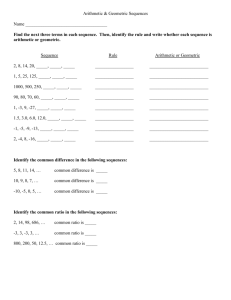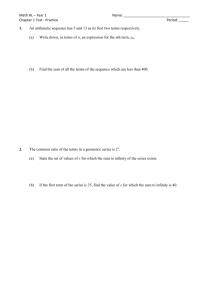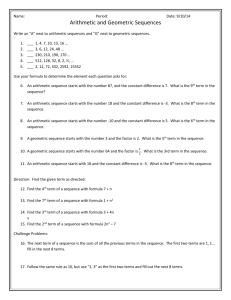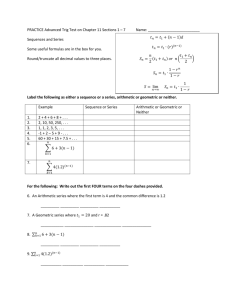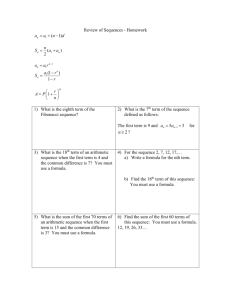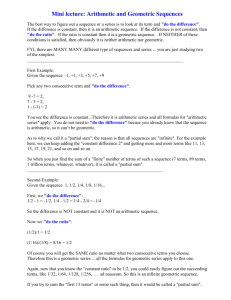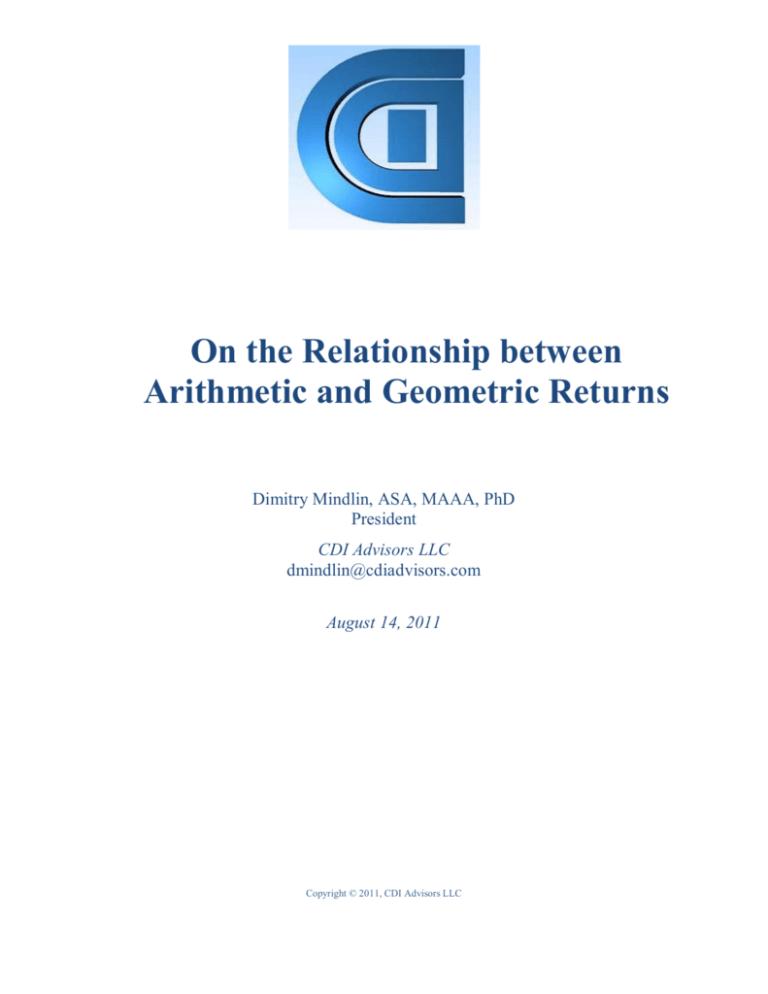
On the Relationship between
Arithmetic and Geometric Returns
Dimitry Mindlin, ASA, MAAA, PhD
President
CDI Advisors LLC
dmindlin@cdiadvisors.com
August 14, 2011
Copyright © 2011, CDI Advisors LLC
CDI ADVISORS RESEARCH
Arithmetic and geometric averages are important and somewhat controversial measurements of
the past and future investment returns. Numerous publications have discussed the pros and cons
of these measurements as well as relationships between them. Yet, the controversy surrounding
arithmetic and geometric averages appears to persist.
Vital decisions for pension plans, for example, are often based on estimates of future investment
returns. It is imperative to utilize appropriate measurements of returns and apply them properly
in a forward-looking manner. In particular, it is important to distinguish arithmetic and
geometric averages for asset classes and portfolios as well as specify the relationships between
these averages.
A popular formula presented in several publications stipulates that the geometric average is
approximately equal to the arithmetic average minus half of the variance. However, a proper
justification for this formula and the assessment of the quality of this approximation are hard to
find. Moreover, this popular formula may significantly underestimate the geometric return in
practical applications.
Recognizing the need for clarity in this area and the desirability of alternative solutions, this
paper presents three additional formulas for approximate calculations of geometric averages
and provides simple quantitative explanations for all four formulas. The results of these
formulas are compared to historic geometric averages and to each other. The paper shows in
particular, that the three other formulas are often superior to the popular one.
This author hopes that this paper would be useful to practitioners in clarifying the relationship
between arithmetic and geometric averages as well as their pros and cons.
Arithmetic and geometric averages are some of the most commonly utilized measurements of
investment returns.1 Despite their extensive utilization, however, there has been a great deal of
controversy and confusion surrounding these measurements. A number of publications have
attempted to clarify the issues related to arithmetic and geometric averages, but the controversy
and confusion appear to persist.2
According to de La Grandville [1998], “A number of serious, widely held errors and
misconceptions about the long-term expected rate of return need to be dispelled.” One of these
“misconceptions” is related to the calculation of the geometric return of a portfolio. According
to several publications, “the geometric average is approximately equal to the arithmetic average
minus half of the variance.” Despite the popularity of this formula, few publications attempt to
justify this approximation and gauge its quality.
As demonstrated in this paper, this formula is the result of a couple of relatively crude
approximations. More troubling, this formula tends to underestimate the geometric average.
This tendency, in particular, should be of concern to pension plans that employ geometric
portfolio returns to determine their discount rates.
Arithmetic vs. Geometric Returns
2
8/14/2011
CDI ADVISORS RESEARCH
Calculations of geometric returns can have a significant impact on asset allocation decisions. A
pension plan, for example, may select the lowest risk portfolio with the geometric return equal to
the plan’s discount rate (by itself, an idea of questionable utility). A calculation that
underestimates the geometric return would force the plan to needlessly increase the riskiness of
the portfolio in order to hit the “target” return. In other words, the plan would take additional
risk solely due to questionable math.
Unlike geometric averages, arithmetic averages are relatively easy to use. In particular, the
arithmetic return for a portfolio is equal to the weighted average of the arithmetic returns of
underlying asset classes. This “rule,” however, does not work for geometric returns – a weighted
average of asset classes’ geometric returns is not equal to the geometric return of the
corresponding portfolio. Therefore, there is a need to “convert” arithmetic portfolio returns to
the geometric ones, and vice versa.
Attempting to establish a better understanding of the relationship between arithmetic and
geometric averages, this paper
provides a simple quantitative explanation for the abovementioned popular formula;
presents three more formulas that connect arithmetic and geometric returns;
develops connections between all four formulas;
demonstrates that the popular formula tends to produce sub-optimal results;
identifies the formula that should be expected to produce better results.
Geometric and Arithmetic Averages: Return Series
For a series of returns, this section develops four formulas that connect arithmetic and geometric
averages.
The arithmetic average A of the series of returns r1 ,
of the series:
A
1 n
rk
n k 1
, rn is defined simply as the average value
(1)
One of the main advantages of the arithmetic average is it is an unbiased estimate of the return.
One of the main disadvantages of the arithmetic average is the probability of achieving the
arithmetic average return may be unsatisfactory. In other words, as a prediction of future returns,
the arithmetic average may be too optimistic. Another disadvantage of the arithmetic return is its
“incompatibility” with the starting and ending asset values. Specifically, the starting asset value
n
multiplied by the compounded arithmetic return factor 1 A is greater than the ending asset
value. 3
The concept of geometric average is specifically designed to correct this problem. If A0 and An
are the starting and ending asset values correspondingly, then, by definition,
Arithmetic vs. Geometric Returns
3
8/14/2011
CDI ADVISORS RESEARCH
A0 1 r1
1 rn An
(2)
The geometric average G is defined as the rate of return that connects the starting and ending
asset values if assumed in all periods. Namely, the starting asset value multiplied by the
n
compounded return factor 1 G is equal to the ending asset value:
A0 1 G An
n
(3)
Combining (2) and (3), we get a standard “textbook” definition of the geometric average G:
n
G 1 1 rk
1
n
(4)
k 1
Let us try to determine how the arithmetic and geometric averages relate to each other. Firstly, it
is well-known that the arithmetic average is always greater or equal to the arithmetic average: 4
AG
(5)
Following a long-established tradition, only the first two moments of the underlying variables
will be used in developing relationships between A and G. Therefore, the relationships between
A and G considered in this paper also involve variance V.
Let us present four formulas that connect arithmetic and geometric returns and specify the
required approximations to derive each formula. 5
Formula # 1 (A1)
Let us make the following two approximations on the right side of (4).
1. For all k, replace each factor 1 rk n by its Maclaurin series expansion up to the second
degree.
2. In the resulting product, ignore all summands of the third degree and higher.
1
See the Appendix for more details. After these approximations, the right side of (4) becomes
A V 2 , where V is the sample variance defined as6
V
1 n
2
rk A
n k 1
(6)
Therefore, we get the following relationship (denoted as (A1) throughout this paper):
Arithmetic vs. Geometric Returns
4
8/14/2011
CDI ADVISORS RESEARCH
G A V 2
(A1)
Relationship (A1) is the popular formula discussed above; it is well-known among practitioners.7
Formula # 2 (A2)
Note that (4) implies
1 G
2
n
1 rk
2
n
(7)
k 1
Let us make the following two approximations on the right side of (7).
1. For all k, replace each factor 1 rk n by its Maclaurin series expansion up to the second
degree.
2. In the resulting product, ignore all summands of the third degree and higher.
2
After these approximations, the right side of (7) becomes 1 A V , where V is defined in (6).
Therefore, we get the following relationship (denoted as (A2) throughout this paper):
2
1 G
2
1 A V
2
(A2)
Relationship (A2) is not as well-known as (A1) among practitioners, even though it has been
known for a long time.8 Interestingly, formula (A2) is exact when the return series has just two
points (see the Appendix for more details).
Formula # 3 (A3)
Note that (4) implies
ln 1 G
1 n
ln 1 rk
n k 1
(8)
On the right side of (8), let us replace each summand ln 1 rk by its Taylor series expansion
around A up to the second degree. See the Appendix for more details.
1
2
After this approximation, the right side of (8) becomes ln 1 A V 1 A . Therefore, we
2
get the following relationship (denoted as (A3) throughout this paper):
Arithmetic vs. Geometric Returns
5
8/14/2011
CDI ADVISORS RESEARCH
1
2
ln 1 G ln 1 A V 1 A
2
(A3)
2
1
1 G 1 A exp V 1 A
2
(A3)
or, equivalently,
In this author’s experience, relationship (A3) is little known among practitioners, even though it
has been presented in some publications.9
Formula # 4 (A4)
In (A3), using approximation ln 1 x x , let us replace V 1 A with ln 1 V 1 A
2
2
. As
a result, we get the following relationship (denoted as (A4) throughout this paper):
1 G 1 A 1 V 1 A
2 1 2
(A4)
As demonstrated in the next section, this relationship is exact when arithmetic and geometric
averages (means) are defined for a lognormal distribution.
It should be noted that there is a sequence of approximations and simplifications that turn (A3)
into (A4), as presented above, then turn (A4) into (A2), and then turn (A2) into (A1) (see the
Appendix for more details). It is also worth noticing that the geometric average estimate (A4) is
always greater than (A3), which in turn is always greater than (A2).10 Loosely speaking,
(A2) < (A3) < (A4)
Interestingly, the geometric average estimate (A2) is not necessarily greater than (A1), although
this is true for most practical examples. 11 See the Appendix for more details.
To recap, formulas (A1) – (A4), which work for any return sample, establish approximate
relationships between the geometric and arithmetic averages and the variance. These formulas
are based on Taylor series expansions up to the second degree.
Geometric and Arithmetic Means: Return Distributions
The previous section developed the relationships between the arithmetic and geometric averages
defined for a series of returns. This section, in contrast, develops similar results when the
distribution of return is given. To avoid confusion with the previous section, this section defines
arithmetic and geometric means (rather than averages), which are denoted as E and M
correspondingly (as opposed to averages A and G in the previous section).
In this case, the arithmetic mean E of return R is defined as the expected value of R:12
Arithmetic vs. Geometric Returns
6
8/14/2011
CDI ADVISORS RESEARCH
E E R
The geometric mean M of return R is defined as follows:
M exp E ln 1 R 1
(9)
The primary motivation for these definitions comes from the fact that the arithmetic and
geometric means are the limits of appropriately selected series of arithmetic and geometric
averages, as demonstrated below.
Specifically, let us define arithmetic averages An and geometric averages Gn for a series of
independent identically distributed returns rk :
An
1 n
rk
n k 1
(10)
n
Gn 1 1 rk
1
n
(11)
k 1
According to the Law of Large Numbers (LLN), An converges to E. Also, from (11) we have
ln 1 Gn
Again, according to LLN,
1 n
ln 1 rk
n k 1
(12)
1 n
ln 1 rk and, therefore, ln 1 Gn converge to the expected
n k 1
value E ln 1 R . Consequently, Gn converges to exp E ln 1 R 1 , which is equal to M.
To recap, An converges to E and Gn converges to M when n tends to infinity. As discussed in the
previous section, relationships (A1) – (A4) are true for An and Gn , where sample variance Vn is
defined similar to (6):
Vn
1 n
2
rk An
n k 1
(13)
Since series Vn converges to the variance of returns V when n tends to infinity, relationships (A1)
– (A4) are true for E and M as well:
Arithmetic vs. Geometric Returns
7
8/14/2011
CDI ADVISORS RESEARCH
M E V 2
1 M
2
(A1)
1 E V
2
(A2)
2
1
1 M 1 E exp V 1 E
2
1 M 1 E 1 V 1 E
2 1 2
(A3)
(A4)
It should be emphasized that, as a general principle, one should avoid approximations whenever
direct calculations are possible. 13 As demonstrated below, (A4) represents the exact relationship
between the arithmetic and geometric means under common assumptions.
Let us assume that the return factor 1 R is lognormally distributed, which means ln 1 R is
normally distributed with parameters and . Under this assumption, the following formulas
are well-known:14
1
1 E exp 2
2
(14)
1 M exp
(15)
V exp 2 2 exp 2 1
(16)
It easily follows from (14)-(16) that the geometric mean is calculated as (A4):
1 M 1 E 1 V 1 E
2 1 2
(A4)
Thus, the relationship (A4) is exact under the lognormal assumption.
If there is a need to calculate the arithmetic mean when the geometric mean and the variance are
given, then, from (A4), the arithmetic mean is calculated as follows:
1 E 1 M
1 1
4V
1
2
2 2
1 M
(17)
Which formula among (A1) – (A4) should work better? The utilization of independent
identically distributed lognormal return factors may be a reasonable forward-looking assumption.
Arithmetic vs. Geometric Returns
8
8/14/2011
CDI ADVISORS RESEARCH
Therefore, formula (A4) may be the right choice for forward-looking analysis. A priori,
however, this is not necessarily the case for historical data. The next section explores this issue.
Historical Arithmetic and Geometric Averages
This section presents the arithmetic and geometric averages for historical data and analyzes the
quality of the approximations discussed in prior sections. The section analyzes three sets of
historical data: equity real rates of return (Exhibit 1),15 equity premium relative to bills (Exhibit
2), and equity premium relative to bonds (Exhibit 3) from 1900 to 2005. Each dataset contains
the arithmetic averages, geometric averages and standard deviations calculated exactly. For each
dataset, we calculate four approximations of the geometric averages (A1) – (A4) and compare
the approximations to the actual values.
Exhibit 1
Equity Real Rates of Return, 1900–2005
Data
Arithmetic Standard Geometric
Average Deviation Average
Australia
9.21%
17.64%
7.70%
Belgium
4.58%
22.10%
2.40%
Canada
7.56%
16.77%
6.24%
Denmark
6.91%
20.26%
5.25%
France
6.08%
23.16%
3.60%
Germany*
8.21%
32.53%
3.09%
Ireland
7.02%
22.10%
4.79%
Italy
6.49%
29.07%
2.46%
Japan
9.26%
30.05%
4.51%
Netherlands
7.22%
21.29%
5.26%
Norway
7.08%
26.96%
4.28%
South Africa
9.46%
22.57%
7.25%
Spain
5.90%
21.88%
3.74%
Sweden
10.07%
22.62%
7.80%
Switzerland
6.28%
19.73%
4.48%
U.K.
7.36%
19.96%
5.50%
U.S.
8.50%
20.19%
6.52%
World
7.16%
17.23%
5.75%
World ex-U.S.
7.02%
19.79%
5.23%
Geometric Average Approximation
A1
7.65%
2.14%
6.15%
4.86%
3.40%
2.92%
4.58%
2.26%
4.74%
4.95%
3.45%
6.91%
3.51%
7.51%
4.33%
5.37%
6.46%
5.68%
5.06%
A2
7.78%
2.22%
6.24%
4.97%
3.52%
3.20%
4.71%
2.45%
5.05%
5.09%
3.63%
7.11%
3.62%
7.72%
4.43%
5.49%
6.60%
5.77%
5.17%
A3
7.79%
2.27%
6.26%
5.01%
3.58%
3.43%
4.76%
2.60%
5.20%
5.13%
3.74%
7.16%
3.66%
7.77%
4.46%
5.52%
6.64%
5.78%
5.21%
A4
7.81%
2.32%
6.28%
5.04%
3.64%
3.63%
4.81%
2.73%
5.35%
5.17%
3.84%
7.20%
3.71%
7.82%
4.49%
5.55%
6.67%
5.80%
5.24%
Best
A1
A4
A2
A4
A3
A2
A4
A2
A1
A4
A4
A4
A4
A4
A4
A2
A1
A2
A4
Worst
A4
A1
A1
A1
A1
A4
A1
A4
A4
A1
A1
A1
A1
A1
A1
A1
A4
A1
A1
* excludes 1922–1923
Source: Dimson, Marsh, and Staunton (2006).
Arithmetic vs. Geometric Returns
9
8/14/2011
CDI ADVISORS RESEARCH
Exhibit 2
Equity Premium Relative to Bills, 1900–2005
Data
Arithmetic Standard Geometric
Average Deviation Average
Australia
8.49%
17.00%
7.08%
Belgium
4.99%
23.06%
2.80%
Canada
5.88%
16.71%
4.54%
Denmark
4.51%
19.85%
2.87%
France
9.27%
24.19%
6.79%
Germany*
9.07%
33.49%
3.83%
Ireland
5.98%
20.33%
4.09%
Italy
10.46%
32.09%
6.55%
Japan
9.84%
27.82%
6.67%
Netherlands
6.61%
22.36%
4.55%
Norway
5.70%
25.90%
3.07%
South Africa
8.25%
22.09%
6.20%
Spain
5.46%
21.45%
3.40%
Sweden
7.98%
22.09%
5.73%
Switzerland
5.29%
18.79%
3.63%
U.K.
6.14%
19.84%
4.43%
U.S.
7.41%
19.64%
5.51%
World
5.93%
19.33%
4.23%
World ex-U.S.
6.07%
16.65%
4.74%
Geometric Average Approximation
A1
7.05%
2.33%
4.48%
2.54%
6.34%
3.46%
3.91%
5.31%
5.97%
4.11%
2.35%
5.81%
3.16%
5.54%
3.52%
4.17%
5.48%
4.06%
4.68%
A2
7.15%
2.43%
4.55%
2.61%
6.56%
3.80%
4.01%
5.70%
6.26%
4.24%
2.48%
5.97%
3.26%
5.70%
3.60%
4.27%
5.60%
4.15%
4.76%
A3
7.17%
2.49%
4.57%
2.64%
6.62%
4.05%
4.05%
5.90%
6.37%
4.29%
2.57%
6.02%
3.30%
5.74%
3.63%
4.30%
5.63%
4.18%
4.77%
A4
7.18%
2.55%
4.59%
2.67%
6.69%
4.27%
4.08%
6.07%
6.48%
4.34%
2.66%
6.06%
3.34%
5.79%
3.65%
4.33%
5.66%
4.21%
4.79%
Best
A1
A4
A2
A4
A4
A2
A4
A4
A4
A4
A4
A4
A4
A3
A3
A4
A1
A4
A2
Worst
A4
A1
A1
A1
A1
A4
A1
A1
A1
A1
A1
A1
A1
A1
A1
A1
A4
A1
A1
* excludes 1922–1923
Source: Dimson, Marsh, and Staunton (2006).
Arithmetic vs. Geometric Returns
10
8/14/2011
CDI ADVISORS RESEARCH
Exhibit 3
Equity Premium Relative to Bonds, 1900–2005
Data
Arithmetic Standard Geometric
Average Deviation Average
Australia
7.81%
18.80%
6.22%
Belgium
4.37%
20.10%
2.57%
Canada
5.67%
17.95%
4.15%
Denmark
3.27%
16.18%
2.07%
France
6.03%
22.29%
3.86%
Germany*
8.35%
27.41%
5.28%
Ireland
5.18%
18.37%
3.62%
Italy
7.68%
29.73%
4.30%
Japan
9.98%
33.06%
5.91%
Netherlands
5.95%
21.63%
3.86%
Norway
5.26%
27.43%
2.55%
South Africa
7.03%
19.32%
5.35%
Spain
4.21%
20.20%
2.32%
Sweden
7.51%
22.34%
5.21%
Switzerland
3.28%
17.52%
1.80%
U.K.
5.29%
16.60%
4.06%
U.S.
6.49%
20.16%
4.52%
World
5.18%
15.19%
4.10%
World ex-U.S.
5.15%
14.96%
4.04%
Geometric Average Approximation
A1
6.04%
2.35%
4.06%
1.96%
3.55%
4.59%
3.49%
3.26%
4.52%
3.61%
1.50%
5.16%
2.17%
5.01%
1.75%
3.91%
4.46%
4.03%
4.03%
A2
6.16%
2.42%
4.13%
1.99%
3.66%
4.83%
3.56%
3.49%
4.89%
3.72%
1.62%
5.27%
2.23%
5.16%
1.78%
3.97%
4.56%
4.08%
4.08%
A3
6.18%
2.45%
4.16%
2.01%
3.71%
4.94%
3.59%
3.65%
5.12%
3.76%
1.75%
5.30%
2.27%
5.21%
1.80%
3.99%
4.60%
4.09%
4.09%
A4
6.21%
2.49%
4.18%
2.03%
3.76%
5.04%
3.61%
3.80%
5.32%
3.81%
1.86%
5.33%
2.31%
5.26%
1.83%
4.01%
4.63%
4.10%
4.10%
Best
A4
A4
A3
A4
A4
A4
A4
A4
A4
A4
A4
A4
A4
A3
A3
A4
A2
A4
A1
Worst
A1
A1
A1
A1
A1
A1
A1
A1
A1
A1
A1
A1
A1
A1
A1
A1
A4
A1
A4
* excludes 1922–1923
Source: Dimson, Marsh, and Staunton (2006).
Exhibits 1-3 contain data for 17 countries plus two totals – 19 data series overall. For each data
series, we measure the distance between approximations (A1) – (A4) of the geometric average
and the actual geometric average. The approximation that is closest to actual value is ranked the
best; the farthest is ranked the worst. For example, looking at the data for Australia in Exhibit 3,
(A1) is 18 bps away from the actual value (6.04% vs. 6.22%), (A2) is 6 bps away from the actual
value (6.16% vs. 6.22%), (A3) is 4 bp away from the actual value (6.18% vs. 6.22%), and (A4) is
1 bp away from the actual value (6.21% vs. 6.22%). Therefore, (A4) is ranked the best and (A1)
is ranked the worst.
For each exhibit and each approximation, we count the number of data series for which the
approximation is the best and the worst. These counts are presented in Exhibit 4.
Arithmetic vs. Geometric Returns
11
8/14/2011
CDI ADVISORS RESEARCH
Exhibit 4
Approximation Rankings
A1
Best Worst
A2
Best Worst
A3
Best Worst
A4
Best Worst
Equity Premium
Relative to Bonds
(Exhibit 1 )
3
14
5
0
1
0
10
5
Equity Premium
Relative to Bills
(Exhibit 2 )
2
16
3
0
2
0
12
3
Equity Real Rates
of Return
(Exhibit 3 )
1
17
1
0
3
0
14
2
Total #
6
47
9
0
6
0
36
10
82%
16%
0%
11%
0%
63%
18%
Total % 11%
Exhibit 5
A4 Compared to A1-A3
A4 is better than A1
A4 is better than A2
A4 is better than A3
Equity Premium
Relative to Bonds
(Exhibit 1 )
14
11
10
Equity Premium
Relative to Bills
(Exhibit 2 )
16
13
12
Equity Real Rates
of Return
(Exhibit 3 )
17
14
14
Total #
47
38
36
Total %
82%
67%
63%
Arithmetic vs. Geometric Returns
12
8/14/2011
CDI ADVISORS RESEARCH
Overall, (A4) largely looks better than (A1) – (A3), as it is the best approximations in 63% cases
(see Exhibit 4). (A1) largely looks worse than (A2) – (A4), as it is the worst approximation in
82% cases (see Exhibit 4). (A2) and (A3) are mostly in-between, and they are never the worst.
The results within Exhibits 1-3 are consistent with this conclusion.
Exhibit 5 contains the results of direct comparisons of (A4) to (A1) – (A3) for each data series.
(A4) works better than (A1) in 82% cases, better than (A2) in 67% cases, and better than (A3) in
63% cases. The results within Exhibits 1-3 are consistent with this conclusion. While the results
of (A4) are not vastly superior, they do demonstrate a clear pattern. Another clear pattern is the
tendency of (A1) to underestimate the geometric return. It happens in 56 out of 57 data series,
and, sometimes, by a significant margin.
Yet, (A1) should not be dismissed easily, not so fast, at least. (A1) provides the best match for
the U.S. data in Exhibits 1 and 2; it is a close second in Exhibit 3, in which it is also the best
match for the “World ex. U.S.” data series.
The results of (A1) – (A4) can occasionally be far apart, especially for high volatility portfolios.
Let us consider the following example. Exhibit 6 shows the data for the U.S. stocks divided into
“large” and “small” stocks (as defined in the source). For the large stocks, (A1) is the best and
(A4) is the worst approximation. For the small stocks, the opposite is true – (A4) is the best and
(A1) is the worst approximation. But (A1) is not just the worst approximation among the four –
it is astounding 162 bps lower than the actual value. (A2) is 100 bps closer, but still
disappointing 62 bps below the actual value. (A3) is another 37 bps closer, but still 25 bps below
the actual value. (A4) is the only one that provides a decent approximation.
Exhibit 6
U.S. Large and Small Stocks
Large Stocks
Arithmetic Average
Geometric Average
Standard Deviation
Data
12.49%
10.51%
20.30%
Geometric Average Approximation
A1
A2
A3
A4
10.43%
10.64%
10.67%
10.70%
Data
18.29%
12.19%
39.28%
Geometric Average Approximation
A1
A2
A3
A4
10.57%
11.57%
11.94%
12.26%
Small Stocks
Arithmetic Average
Geometric Average
Standard Deviation
Source: Bodie [2004], Table 5.3, p. 141.
Arithmetic vs. Geometric Returns
13
8/14/2011
CDI ADVISORS RESEARCH
Conclusion
This paper analyzes the following four relationships between arithmetic and geometric averages
(means) that work for any return sample:
G A V 2
1 G
2
(A1)
1 A V
2
(A2)
2
1
1 G 1 A exp V 1 A
2
1 G 1 A 1 V 1 A
2 1 2
(A3)
(A4)
When the return factor is lognormally distributed (a common forward-looking assumption), the
relationship (A4) is exact:
1 M 1 E 1 V 1 E
2 1 2
(A4)
In this case, there is no need for approximations.
Relationship (A1) is the simplest, popularized in many publications, but usually sub-optimal and
tends to underestimate the geometric return. Relationships (A2) – (A4) are slightly more
complicated, but, in most cases, should be expected to produce better results than (A1).
Overall, (A4) looks like a winner – it works better in both backward- and forward looking
settings. Still, (A1) – (A3) should not be dismissed summarily, and more research is needed to
determine the conditions under which a particular formula may work better. For a practitioner, it
may be a good idea to compare the results of all four formulas. There may be significant
disparities among these approximations, especially for high volatility portfolios.
Both arithmetic averages and geometric averages are required for a clear understanding of
investment returns. This author hopes that this paper would be useful to practitioners in
clarifying the relationships between these averages as well as their pros and cons.
Arithmetic vs. Geometric Returns
14
8/14/2011
CDI ADVISORS RESEARCH
APPENDIX: The Development of Formulas (A1) – (A3) and Transitions from (A4) to (A1)
This Appendix contains the technical details of the development of formulas (A1) – (A4). The
arithmetic average A of a series of returns r1 , , rn is defined as the average value of the series:
A
1 n
rk
n k 1
(1)
The geometric average G of a series of returns r1 ,
n
G 1 1 rk
, rn is defined as follows:
1
n
(4)
k 1
Sample variance V is defined as
V
1 n
2
rk A
n k 1
(6)
Formula # 1 (A1)
Let us take the Maclaurin series expansion for the function f x 1 x n up to the second
degree and ignore the remainder:
1
1 x
1
n
1
1
1 n
x 2 x2
n
2n
(18)
Substituting (18) into (4) and ignoring summands of the third degree and higher, we get (A1):
n
1 n
1
G 1 1 rk 2 rk2
n
2n
k 1
n
n
n
1
1
1 n
rk 2 rk rl 2 rk2
n k 1
n k l
2n k 1
A V 2
(19)
Formula # 2 (A2)
From the definition of G, we get
1 G
2
n
1 rk
2
n
(20)
k 1
Arithmetic vs. Geometric Returns
15
8/14/2011
CDI ADVISORS RESEARCH
Let us take the Maclaurin series expansion for the function f x 1 x n up to the second
degree and ignore the remainder:
2
1 x
2
n
1
2
2n 2
x
x
n
2n 2
(21)
Substituting (21) into (20) and ignoring summands of the third degree and higher, we get (A2):
n
2n 2
2
1 xk
xk
n
2n 2
k 1
n
2
4
2n n
1 xk 2 xk xl 2 xk2
n i 1
n k l
n k 1
1 G
2
(22)
1 A V
2
Formula # 3 (A3)
Let us take the Taylor series expansion for the function f x ln 1 x around point A up to the
second degree and ignore the remainder:
ln 1 x ln 1 A
x A x A
1 A 2 1 A2
2
(23)
Using (23) on the right side of (8), we get (A3):
1 n
ln 1 rk
n k 1
n
1
1
1 n
2
ln 1 A
r
A
rk A
k
2
n 1 A k 1
2 1 A n k 1
ln 1 G
ln 1 A
(A3)
V
2 1 A
2
Now, below are the sequences of approximations and simplifications that turn (A3) into (A4),
then turn (A4) into (A2), and then turn (A2) into (A1) as well as the proof that
(A2) < (A3) < (A4)
(A3) – (A4) Transition
Arithmetic vs. Geometric Returns
16
8/14/2011
CDI ADVISORS RESEARCH
The transition from (A3) to (A4) is achieved via replacing V 1 A with ln 1 V 1 A
2
2
(using approximation ln 1 x x ). Noting that 1 x exp x , we get
1 A exp
1
2
2
V 1 A 1 A 1 V 1 A
2
1 2
which means the geometric average estimate (A4) is no less than (A3).
(A4) – (A2) Transition
The transition from (A4) to (A2) is achieved via replacing 1 V 1 A
2 1
with 1 V 1 A
2
(using approximation 1 x 1 x ). Noting that 1 x 1 x , we get
1
1 A 1 V 1 A
1
2 1 2
1 A 1 V 1 A
1 A V
2 1 2
12
2
which means the geometric average estimate (A3) is no less than (A2).
(A2) – (A1) Transition
The transition from (A2) to (A1) is achieved via replacing 1 G and 1 A with 1 2A and
2
2
1 2G correspondingly (using approximation 1 x 1 2 x ).
2
The geometric average estimate (A1) is not necessarily less than (A2), although this is true for all
data series in Exhibits 1- 3 and most practical applications. For example, if r1 99% and
r2 100% , then the geometric average estimate (A1) is equal to -49%, and the geometric
average estimate (A2) is equal to -86% (which is equal to the actual geometric average of this
return series, see below).
Finally, formula (A2) is exact when the return series contains just two points, due to the
following.
1
1
2
r1 r2 r12 r22
2
2
1
1
2
2
1
1 r1 r2 r1 r2 r12 r22 r1 r2
4
4
2
1 G
2
1 r1 1 r2 1 r1 r2
1 A V
2
Arithmetic vs. Geometric Returns
17
8/14/2011
CDI ADVISORS RESEARCH
REFERENCES
Bodie, Z., Kane, A., Marcus, A.J. [1999]. Investments, McGraw-Hill, 4th Ed., 1999.
Bodie, Z., Kane, A., Marcus, A.J. [2004]. Essentials of Investments, McGraw-Hill, 2nd Ed.,
2004.
Booth, D.G., Fama, E.F. [1992]. Diversification Returns and Asset Contributions, Financial
Analysts Journal, May/June 1992, p. 26–32.
de La Grandville, O. [1998]. The Long-Term Expected Rate of Return: Setting It Right,
Financial Analysts Journal, November/December 1998, p. 75–80.
Dimson, E., Marsh, P., Staunton, M. [2006]. The Worldwide Equity Premium: A Smaller Puzzle,
London Business School, April 2006,
http://papers.ssrn.com/sol3/papers.cfm?abstract_id=891620.
de La Grandville, O., Pakes, A.G., Tricot, C. [2002]. Random Rates of Growth and Return:
Introducing the Expo-Normal Distribution, Applied Stochastic Models in Business and Industry,
2002; 18:23–51.
Hughson, E., Stutzer, M., Yung, C. [2006]. The Misuse of Expected Returns, Financial Analysts
Journal, November/December 2006, p. 88-96.
Jacquier, E., Kane, A, Marcus, A. [2003]. Geometric Mean or Arithmetic Mean: A
Reconsideration, Financial Analysts Journal, November/December 2003, p. 46-53.
Jean, W.H., Helms, W.P. {1983]. Geometric Mean Approximations, Journal of Financial and
Quantitative Analysis, Vol. 18, No. 3, September, 1983, p. 287-293.
Jordan, B. D., Miller, T. W. [2008] Fundamentals of Investments, McGraw-Hill, 4th Ed., 2008.
Klugman, S.A., Panjer, H.H., Willmot, G.E. [1998] Loss Distributions, Wiley, 1998.
Latane, H.A. [1959]. Criteria for Choice among Risky Ventures, Journal of Political Economy,
Vol. 67, April 1959, p. 144-155.
MacBeth, J.D. [1995]. What’s the Long-Term Expected Return to Your Portfolio? Financial
Analysts Journal, September/October 1995, p. 6–8.
Maginn, J.L., Tuttle, D.L., McLeavey, D.W., Pinto, J.E. [2007]. Managing Investment
Portfolios, Wiley, 3rd Ed., 2007.
Markowitz, H.M. [1991]. Portfolio Selection, 2nd Ed., Blackwell Publishing, 1991.
Siegel, J. J. [2008] Stocks for the Long Run, McGraw-Hill, 4th Ed., 2008, p. 22.
Pinto, J. E., Henry, E., Robinson, T. R., Stowe, J. D. Equity Asset Valuation, Wiley, 2nd Ed.,
2010.
Arithmetic vs. Geometric Returns
18
8/14/2011
CDI ADVISORS RESEARCH
Important Information
This material is intended for the exclusive use of the person to whom it is provided. It may not be
modified, sold or otherwise provided, in whole or in part, to any other person or entity.
The information contained herein has been obtained from sources believed to be reliable. CDI Advisors
LLC gives no representations or warranties as to the accuracy of such information, and accepts no
responsibility or liability (including for indirect, consequential or incidental damages) for any error,
omission or inaccuracy in such information and for results obtained from its use. Information and
opinions are as of the date indicated, and are subject to change without notice.
This material is intended for informational purposes only and should not be construed as legal,
accounting, tax, investment, or other professional advice.
Copyright © 2011, CDI Advisors LLC. All rights reserved. No part of this publication may be reproduced
or transmitted in any form or by any means, electronic or mechanical, including photocopying, recording,
or by any information storage and retrieval system, without permission in writing from CDI Advisors
LLC.
1
Arithmetic and geometric averages are two of the three classical Pythagorean means. The third one is the
harmonic average.
2
For example, see MacBeth [1995], de La Grandville [1998], Jacquier [2003], Hughson [2006].
3
rn , then
That is, obviously, if returns r1 , , rn are not all the same, as assumed in this section. If r1 r2
the problem is trivial as the arithmetic and geometric averages are equal.
4
This fact is a corollary of the Jencen’s inequality.
5
For the purposes of this section, the concerns about the quality of these approximations are set aside.
6
For the purposes of this paper, the concern that the sample variance as defined in (7) is not an unbiased estimate is
set aside.
7
For example, see Bodie [1999], p. 751, Jordan [2008], p. 25, Pinto [2010], p. 49.
8
According to Jean, Helms [1983], formula (A2) was originally proposed in Latane [1959].
9
For example, see Markowitz [1991], p. 122, Jean, Helms [1983], Booth, Fama [1992].
10
Reminder: in this section, it is assumed that returns r1 , , rn are not all the same (see endnote 3).
The geometric average estimate (A1) is less than (A2) when A V 4 , which is usually the case.
We assume that the first and the second moments of the return distribution are finite.
13
de La Grandville [1998] and de La Grandville [2002] contain a similar message.
14
For example, see Klugman [1998], p. 582.
15
This data is also presented in Maginn [2007], Exhibit 7-2, p. 410.
11
12
Arithmetic vs. Geometric Returns
19
8/14/2011

